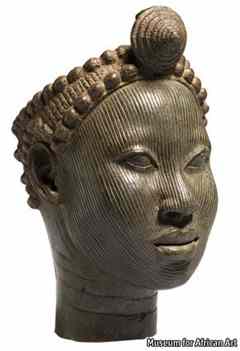AFTER acclaim in Spain and Britain, “Dynasty and Divinity”, the first big exhibition devoted to sculpture from the Kingdom of Ife (in present-day Nigeria), begins an 18-month tour of America in Houston on September 19th.
 The show, which consists of works in stone, terracotta and metal made between the 9th and 15th centuries, is a revelation and a treat. Art from dramatically different cultures is often hard to connect with, but these sculptures are naturalistic and remarkably accessible.
The show, which consists of works in stone, terracotta and metal made between the 9th and 15th centuries, is a revelation and a treat. Art from dramatically different cultures is often hard to connect with, but these sculptures are naturalistic and remarkably accessible.
Whether the subject is an animal, a person or a mythical creature, each image is well observed and has tremendous presence.
More than 100 works are on view. All are loans from Nigeria’s National Commission for Museums and Monuments. Some have left Africa for the first time. Text and photo murals on the walls instruct visitors about the kingdom, an unbroken monarchy for more than 800 years.
Today Ife is a city of 600,000 people. Its present ruler or Ooni is Alayeluwa Oba Okunade Sijuwade, Olubuse II; now aged 80, he studied in Britain, became a businessman and is enjoyably wealthy.
The background information is interesting but limited. The art itself makes a powerful impact. Some of it is unnerving. A few of the terracotta heads are gagged; others are deformed by birth defects or disease.
The dozen or more heads in copper alloy are exciting in a less complicated way; their faces radiate serenity. Ten of them are life-sized. The three that are somewhat smaller are topped by crowns decorated with what appear to be rings of beads.
These heads are beautiful, technically sophisticated and compelling. At the time they were created, between the 14th and early 15th centuries, the city-state of Ife was a centre of trade, weaving and bead manufacture. It was a period of peace and prosperity, the kingdom’s golden age.
Some of the objects in the exhibition used to play a part in rituals. But were they made for that purpose? Ife has no written early history. Many of the works were chance discoveries.
There is no archaeological record to help scholars find answers to the many questions that they raise. Were the copper-alloy heads the work of a single artist or workshop? Are the heads portraits or idealised images? Are the scars on some of the brass and terracotta faces a means of suggesting beaded veils of the sort that are still in use today? Are all the heads male? It is almost impossible to be sure of the sex of one or two.
In the 15th century metal casting in Ife stopped abruptly. This was when the Portuguese arrived on West Africa’s coast. The neighbouring Kingdom of Benin supplanted inland Ife as a trading centre and the metal casters may have moved to where they were more likely to find patrons.
The best of Benin’s famous, more stylised bronzes were made between the 15th and 18th centuries. But Ife remained and remains the spiritual home of the Yoruba-speaking people.
In 1910 Leo Frobenius, a German explorer, saw Ife’s superbly modelled terracotta sculptures and a single brass head. He thought they were too good to have been made by Africans and concluded that the sculptors must have been survivors of Atlantis, the submerged island of Greek legend. Along with expressions of excitement, there were echoes of this reaction in 1938 when Europeans first saw a cache of newly unearthed brass heads.
Now these reactions seem shockingly bigoted or, at best, quaintly narrow-minded: the skill and imagination of African artists is generally recognised. Ife sculpture is seen to be sophisticated, not primitive.
Appropriately, the show is touring art, rather than ethnographical, institutes. Its last stop before returning to Nigeria will be in the handsome new building of New York’s African art museum now rising at the corner of 110th Street and Fifth Avenue.
“Dynasty and Divinity: Ife Art in Ancient Nigeria” will be at the Museum of Fine Arts, Houston, September 19th-January 9th 2011; Virginia Museum of Fine Arts, Richmond, February 12th-May 22nd; Indianapolis Museum of Art, Indianapolis, July 8th-October 9th; Museum for African Art, New York, November 11th-April 8th 2012.
Source: The Economist [September 02, 2010]